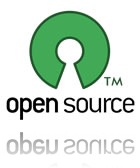As I'm in the process of updating my website’s Learning Content Management System (LCMS), I though it would be interesting to discuss open source environments, and how they  can be implemented in an e-learning content development ecosystem.
can be implemented in an e-learning content development ecosystem.
Context
When I began developing my website and blog, I decided to use an open standards approach during the course of their initial development, as much for philosophical as for financial or any other reasons. Consequently, as I implement new features (such as my podcasts), and maintain and enhance site functionality, I adhere to the approach, principles and methodologies of the Open Source movement in as far as is practicable.
Now read on...
In as much as is possible, I try to develop content using non-proprietary tools, usually freely available under the GNU Licence. Examples of this type of software include:
- Audacity - an audio editor
- Freemind - a mind mapping tool
- OpenOffice.org - an office application suite for a range of operating systems including Windows and Linux
- NeoOffice - A port of OpenOffice.org to the MacOS X platform.
- Apache - a Web server.
- PHP – a scripting language.
- MySQL - database software.
The Gratis versus Libre Debate
It is important to define usage of the word “open” in the term “open environment:” in this context, I qualify the use of "open" as adhering to the openformats.org definition:
We will say that a file format is open if the mode of presentation of its data is transparent and/or its specification is publicly available. Open formats are ordinarily standards fixed by public authorities or international institutions whose aim is to establish norms for software interoperability. There are nevertheless cases of open formats promoted by software companies which choose to make the specification of the formats used by their products publicly available.
It should be noted that an open format can either be coded in a transparent way (readable in any text editor: this is the case of markup languages) or in a binary mode (unreadable in a text editor but thoroughly decodable once the format specifications are known) .
I should note that while most of the tools I will discuss in this series of articles are ‘true’ open source applications - freely distributable (“free as in speech”), some (like Microsoft Movie Maker) are free from cost - “in the sense that one does not have to pay for some good or service. ” (Wikipedia.org).
My view is that both categories of software enable me to meet my objective of developing courseware, and being of a practical bent, I don't really suffer an ethical dilemma in combining a range of tools if they assist me in achieving my goals. However, I think that it is important to discuss the implications of open software, particularly as the debate is central to the notion of specifications and standards, and how they are implemented. I haven't discussed learning standards yet in my blog, but it is a topic I will be talking about at a later time; I think that elements of this discussion reflect directly on SCORM, AICC, QTI and other learning-related specifications and standards.
What is "free" software?
Free software is a matter of the users' freedom to run, copy, distribute, study, change and improve the software. More precisely, it refers to four kinds of freedom, for the users of the software:
- The freedom to run the program, for any purpose (Freedom 0).
- The freedom to study how the program works, and adapt it to your needs (Freedom 1). Access to the source code is a precondition for this.
- The freedom to redistribute copies so you can help your neighbor (Freedom 2).
- The freedom to improve the program, and release your improvements to the public, so that the whole community benefits (Freedom 3). Access to the source code is a precondition for this.
A program is free software if users have all of these freedoms. Thus, you should be free to redistribute copies, either with or without modifications, either gratis or charging a fee for distribution, to anyone anywhere. Being free to do these things means (among other things) that you do not have to ask or pay for permission.
(GNU.org)
So, how can we reconcile using free-from-cost software (which usually comes with the kinds of restrictions associated with commercial organizations' End User License Agreements) with this manifesto?
More...
--





No comments:
Post a Comment